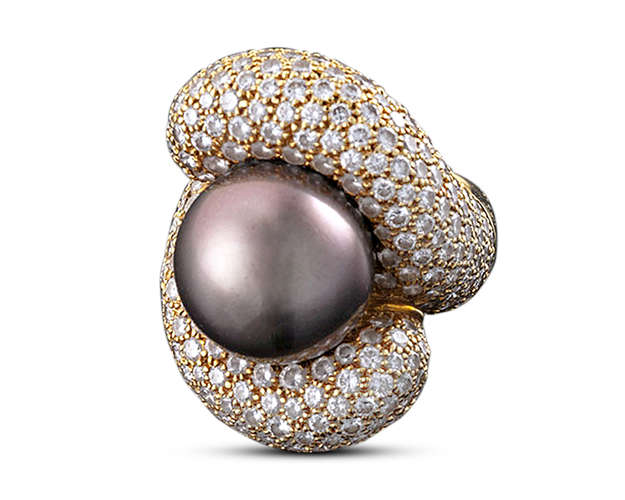
Materials and Environment
For these reasons, it is recommended that pearls and opals be kept in a soft pouch or lined jewelry box, where there is some exposure, and they are unlikely to be scratched. Safety deposit boxes and safes are generally very dry, hard and airtight environments and are therefore not ideal.

Silver
Silver is notoriously sensitive, as it is quick to react to the environment and tarnish. It is imperative to keep your silver in a cool, dry place to combat frequent trips to your jeweler for cleaning and polishing. We recommend storing silver jewelry in an anti-tarnish pouch or acid-free archival tissue paper. Alternatively, you can keep it in a compartment, drawer or storage box with anti-tarnish strips. The less exposure to the outside elements your items have, the better; airtight spaces are ideal.
Gold
Perhaps the most coveted of the precious metals, gold should be stored on its own in a separate storage box. With a purity of 99.99%, 24K gold is extraordinarily soft and, because of this, is not often used in jewelry applications. Alloyed 10k, 14k and 18k gold is stronger but is still very susceptible to marks, dings and scratches. Therefore, you should store your gold items in a soft, dry, and secure area.
Unsure what kind of metal your jewelry is made of? Look for precious metal stamps and hallmarks.
Diamonds
While diamonds may be a girl’s best friend, they are certainly not a friend to most materials they come into contact with. Used in an array of industrial applications due to their incomparable strength (they rank a 10 on the Mohr scale), diamonds can scratch, dent and mar other pieces. You should safely store diamond jewelry separately or in a way that keeps your pieces from touching to avoid any damage.

Treated Gems
Colored gemstones are uniquely beautiful. Nonetheless, they are sometimes treated to enhance their color and clarity. It is important to know whether your gems are treated, as these treatments can be negatively affected by outside factors such as high heat, humidity and many common solvents and cleaners. If you are unsure whether you own a treated gemstone necklace, bracelet, or set of earrings, consider contacting your jeweler or sending it to the Gemological Institute of America (GIA)for analysis and grading. The findings will help you understand how to store your precious colored gemstones properly.
Tips & Takeaways
- Make sure your jewelry is clean before storing it for a prolonged period.
- Assess the material of your jewelry pieces.
- Store like materials together and in the appropriate environment.
- Consider keeping your pieces in cloth bags, jeweler’s tissue or the original packaging, especially if your jewelry case is not lined with fabric.
Types of Storage
Once you are confident in your knowledge of your jewelry pieces and how to care for them, it is time to pick a storage case! Throughout history, countless vessels have been crafted specifically for the safekeeping of precious gems, earrings, necklace jewelry and other valuables. Often a work of art in and of themselves, these receptacles were the ultimate way to display authority and affluence while keeping prized possessions under lock and key.
Boxes & Caskets
The jewelry box has left an indelible mark on popular culture and is what most people think of when considering jewelry storage. Similar to reliquaries, jewelry boxes, sometimes referred to as “caskets,” have come to symbolize the treasures stored within them. In the middle ages, jewelry boxes were customarily given as engagement gifts from bridegrooms and were a promise of the “jewels to come.” From antiquity to today, jewelry boxes are often crafted of precious materials themselves; some are even made by jewelers.
Perfect for the small to mid-size collection, jewelry boxes often have convenient compartments lined with fabric and sometimes feature a locking mechanism. They are a particularly fine option for men’s jewelry collections, as they can come with special separators for rings, cufflinks, and antique watches. Decorative table-top jewelry boxes, like the one showcased below, have glass for displaying your accessories.

While the term “jewelry casket” can refer to both smaller and larger boxes, they are typically larger and akin to chests, like the one displayed in the video below. Historically, caskets were made for storing royal jewels, relics and wedding dowries and were often important for travel. A few remaining examples of these exceptional caskets date back as early as the 4th century, such as the Brescia Casket from the Roman Empire.
Jewelry caskets are a great storage option for the history lover. They are often ornately decorated and are suitable for mid to large collections.
Armoires and Cabinetry
For more extensive jewelry collections, a jewelry armoire or cabinet may be the best option. Jewelry armoires, like the one below, were particularly popular among the royal courts of the 18th century. Decadence extended to all areas of life, and jewelry storage was no exception! King Louis XVI gifted Marie Antoinette a beautiful tulipwood jewelry table in celebration of their impending marriage, but, despite its largess, it couldn’t fit all of her jewelry. She eventually commissioned an immense diamond cabinet, which stood at eight and a half feet tall by six feet wide. It wasn’t until the Industrial Revolution that jewelry furnishings became widely available.
Like jewelry boxes, armoires and cabinets have wonderfully convenient compartments for storing similar jewelry pieces together. Because of the additional space, however, they often have features that a jewelry box does not, such as a hanging rack for necklaces or a pressboard for pins and brooches.

Safes
Theft protection is important to consider when storing your jewelry, and safes are ideal for securing all of your valuables. Particularly perfect for guarding your jewelry while you are away from home, most jewelry boxes will snugly fit inside a large safe. Much like the beautiful one depicted below, many safes have incredibly complex locking mechanisms and special compartments to safeguard your precious fine jewelry.

Traveling







